The UPS detailed in this article can provide a power output of 50 watts consistently, at 110 volts with a frequency of 60 Hz. The output is fundamentally a sine wave that behaves exactly like standard mains home AC power for the load.
An integrated power supply works like a battery charger. Even though the UPS could be implemented for numerous different applications, it is mainly designed to power a small computer system and important peripheral, like a disk drive, to ensure that a power outages never causes deletion of data or interruption of the program that may be running at the instant.
This implies that this lead acid powered 50 watt UPS circuit is not going to handle bigger PCs, that usually work with over 60 watts of actual power.
One important feature of this UPS circuit is that it outputs a "clean" sinewave AC power: and flaws like noise, spikes, or low voltage within the grid AC line will never have an affect on the computer's (loads's) functioning.
Power Supply Relay Changeover Stage
The power supply stage is quite distinctive because it takes in power through a remote 12 volt lead acid or SMF battery and also from your AC power line, the battery here becomes the most crucial element for the UPS functioning.
As revealed in Fig. 1 below, when CHARGE-OFF-OPERATE switch S1 is positioned to either the CHARGE or OPERATE setting, relay RY2 is activated and its contacts provide AC power to the primary windings of the power transformers T1 and T2.
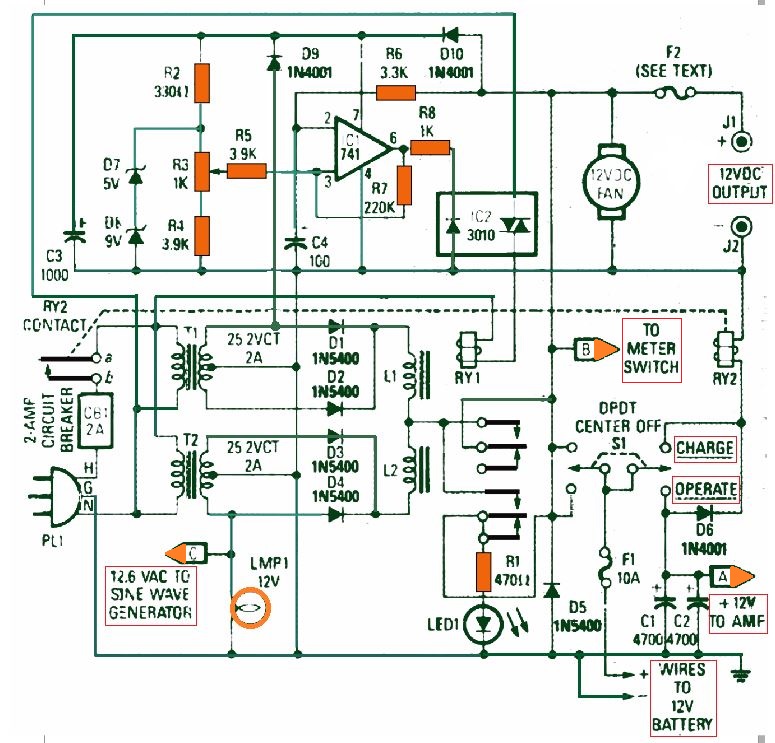
The current through the secondary windings is rectified through diodes D1, D2, D3, and D4.
Chokes L1 and L2 restrict the charging current for the battery as well as prohibit the passage of the ripple current.
Diode D5 delivers "crowbar" overload protection; its function is to safeguard the many vulnerable components by triggering fuse F1 to burn out in case the battery is accidentally hooked up with an incorrect polarity.
Op amp IC1 is connected in the form of an inverting voltage comparator whose reference voltage could be adjusted across a range of 11 to 14 volts through potentiometer R3.
Once the battery voltage falls beneath the reference, opto coupler IC2 is activated, that powers relay RY1. Current passing through RY1's contacts begins charging the battery when the load is not too heavy.
On other hand if the UPS is working at or close to its 100 % potential, an external battery charger may be needed to provide adequate current supply, to prevent the battery from getting discharged.
A 10 ampere battery charger is advisable. Given that the majority of battery chargers don’t have a filtration system, a high value filter capacitor must be included between the charger output and the battery to minimize ripple current.
In order to prevent battery overcharging, the supply from the charger must be switched on only when the UPS is being loaded at its 100 % capacity.
Fuse F2 must be less than 10 amps in order that the primary fuse, F1, may not whack when the 12 volt output is unintentionally shorted.
The Transistor Amplifier Stage
As presented in Fig. 2 below, the UPS AC output is generated from a transformer-coupled Class B amplifier circuit.
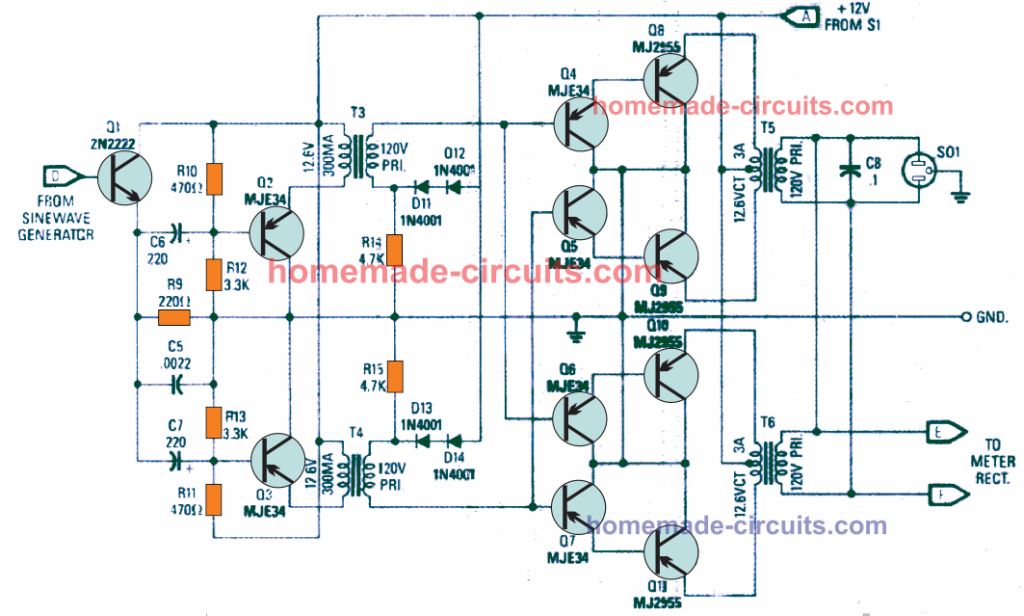
The 4 sets of Darlington transistors (Q4-Q8, Q5-Q9, Q6-Q10 and Q7-Q11) work llike emitter-follower networks to deliver voltage to the power transformers T5 and T6 primary windings.
Capacitor C8 cancels out any high frequency ingredients which originate due to high voltage crossover distortion or clipping, and in addition inhibits high frequency self oscillation.
Two of the Darlington sets are powered in parallel through transformer T3; another couple are pushed in parallel by means of T4.
Diodes D11, D12, D13, and D14 produce a constant DC base voltage which biases the output transistors at around the cutoff region.
The Class A driver network formed by the transistors Q2 and Q3, are similarly fully made up of emitter followers. The essential voltage step-up is implemented by the transformers T5 and T6, which are also typical power transformers configured in the reverse order.
Transistor Q1 drives transistors Q2 and Q3 in parallel. The Q1 base is directly connected to the IC5-d output (see Fig. 3), which is at 4.5 volts DC.
Reversal of Phase for push-pull drive of the output stage is achieved by appropriately wiring the secondaries of transformer T3 and T4 transformers.
The Sinewave Generator
As revealed in Fig. 3 below, the oscillator stage is configured using IC4, which is a 567 tone detector.
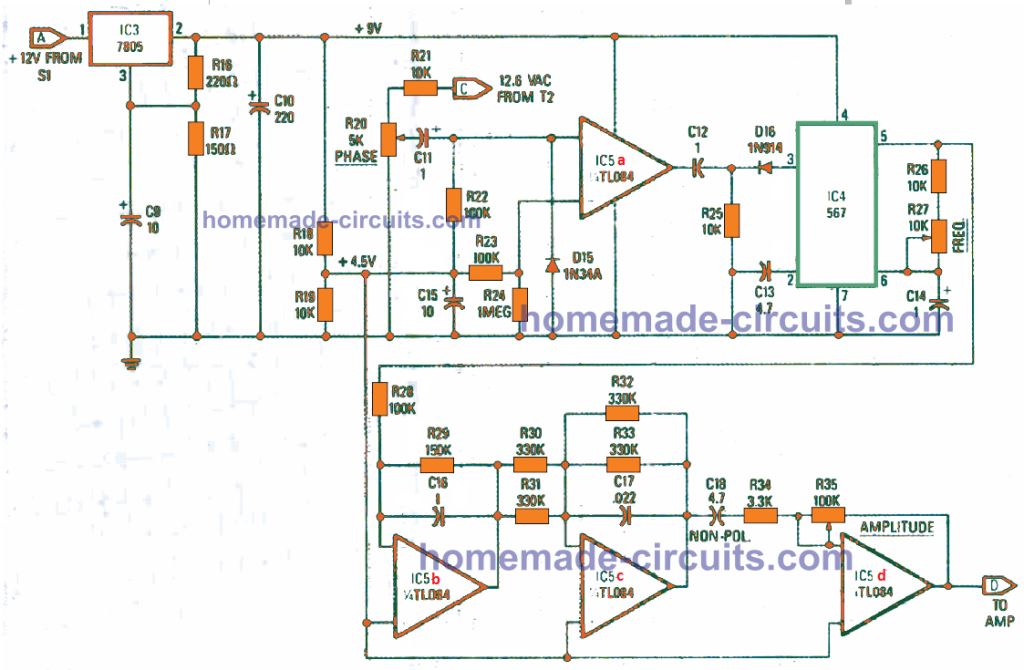
The IC's frequency is set up by resistors R26 and R27, and capacitor C14, and is fixed to a precise 60 Hz. IC4's square wave output is transformed to a triangle wave by IC5-b, which is further on converted to a sinewave by IC5-c.
Op amp IC5-d's gain is set by potentiometer R35, that is fixed at the AC output voltage.
Op amp IC5-a converts the sinewave from the T2 output to a 60 Hz frequency.
D15 safeguards against damage that may take place in case the op amp inverting input happens to turn negative with reference to ground; the diode is generally reverse biased.
The 60 Hz pulses, that are connected to IC4 via C12 and D16, trigger the oscillator to lock to the grid AC frequency. Some extent of control on the precise phase synchronization is achievable by fine-tuning potentiometer R20.
Once correctly tweaked, the AC output is going to lock in-phase with the input AC grid line, and this locking/unlocking process during the input power failure and restoration would be soft and favorable, producing almost no interference.
The sine wave generator comes with smooth, ripple-free 9 volt power through IC3, a 7805 IC, 5 V regulator. Pin 3 of the regulator is kept at 4 volts above ground line with the help of resistive divider R16 and R17 to get a precise 9 volts output.
The Meter Circuit
It may be possible to monitor either the battery voltage or the AC output voltage through a meter circuit as exhibited in Fig. 4 below.
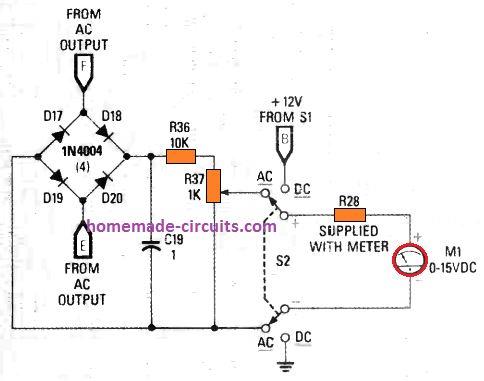
A bridge rectifier consisting of four rectifier diodes converts the AC to DC, while the capacitor C19 smooths to a pure DC.
A DPDT switch hooks up a 15 V DC voltmeter with the 12 V supply or the voltage divider built using resistive divider of R36 and R37.
How to Test the Power Supply Changeover
It may be important to test the power supply section before the amplifier is wired up. This can be carried out before even the amplifier stage is assembled.
For this you can adjust the R3's slider arm towards the end which is linked to R4.
Do not connect the mains-cord into an electrical outlet yet. Attach a 12 V lead acid battery to the supply and position S1 to either CHARGE or OPERATE.
Now, the relay RY2 could be seen activated and LED1 illuminated. At this point you may find around 12 V at pins 2 and 7 of IC1.
Pin 6 should show logic low. Next, connect the mains cord into an AC outlet. Lamp LMP1 will now light up. Relay RY1 should continue to be switched OFF and you would test approximately 14 V at its normally open contacts.
Pin 7 of IC1 should indicate around 14 V and pin 3 around 11 volts. Pin 6 should indicate a logic low.
Turn R3 to its reverse end to get 14 V at pin 3; RY1 at this moment must activate with LED1 shutting OFF.
The voltage across the battery points should now read 13 V. Adjust R3 just around the level at which relay RY1 deactivates.
The charger stage must keep switching off and on as the battery voltage goes up and reduces. The accurate setting of R3 may be at the point, where the charger output switches quite rapidly, and switches off practically the moment it switches on.
The battery voltage should be around at 12.5 V mark in the absence of a charging supply. When the battery voltage drops, the charger output must begin switching repeatedly unless of course the battery is so terribly discharged that the full current of the charger is not able to restore the voltage back up to 12.5.
Testing the Sine wave Generator
The testing of the sine wave generator stage can be executed separately. In case you assemble it on the shown PCB without the 9 V regulator IC, then you can use a 9 V PP3 battery or an external equivalent power source for the testing procedure.
Begin by positioning preset R20's slider arm to its ground side. Using an oscilloscope scope should display a square wave signal at pin 5 of IC4.
By supplying a 60 Hz sinewave frequency to the scope's horizontal sweep, adjust resistor R27 to get a frequency of 60 Hz that will generate a rectangular Lissajous waveform.
The frequency does not have to be precisely accurate. A gradually altering waveform pattern can be quite satisfactory. Having the scope set for a standard 60 Hz sweep, make sure the scope indicates a triangle wave on the output of IC5-b and a sinewave at the output of IC5-c.
A sine wave must also be available at the IC5-d output. And its amplitude should vary in response to the adjustment of R35. In case any of these checks tend to be incorrect, examine the presence of a 4.5 volts DC across all the input and output pins.
Next, connect a 12.6 V AC source to R21, and adjust the R20 until the you find the scope showing the output pulses from IC5-a: The oscillator freqeuncy must lock to the input line frequency. Now set the scope to display a Lissajous curve as done previously and monitor the IC5-d output.
You must see an oval pattern which is almost closed. You must be able to possibly fine-tune R20 such that the scope display is almost a sloping straight line, showing that the output signal is in-phase with the grid-line.
Now, if you disconnect the input AC signal by unplugging the mains-cord, the scope pattern must start producing a gradual change to an oval shape display which opens and closes.
Re-allign the potentiometer R27 to reduce the above rate of change. As soon as the input AC frequency is reconnected back, the scope display must instantly come back to the sloping line pattern.
Testing the Meter Circuit
The testing and calibration of the meter circuit could be implemented by attaching the rectifier to the grid AC line.
Pushing S2 in the AC position, fine-tune R37 to get a meter reading that may be 1/10th of the AC input voltage as measured separately through an standard meter reading.
If you find no measurement appearing, look for around 130 volts DC around C19 to ensure that the rectifier is correctly joined. A scope here should display a big ripple element due to the low uF value of the C19 capacitor.
Testing the Amplifier
Begin the test by integrating the power transistor amplifier stage with the 12 V power source and the input sinewave waveform generator.
Adjust the R35 center arm towards end associated with the output side of IC5-d, which decides the setting for a zero output signal.
Now shift the S1 to the "OPERATE" position. You should see a meter reading of 12.5 V at the emitters of Q2, Q3, Q8, Q9, Q10, and Q11.
You may also find these transistors getting a bit warmer, although not hot.
You should be able to see a meter reading of around 11 V at the bases of Q4, Q5, Q6, and Q7, and around 4 V at the Q1 emitter.
While conducting the following testing procedures, be careful while working with the output, since this would be at a lethal mains 117 V level.
Hook up one wire of each of the 120 V windings of the transformer T5 and T6 with each other, leaving the others remain unconnected.
Connect an AC voltmeter with one of the transformer windings and set the meter to a range greater than 110 volts.
After this, little by little turn R35 preset center arm until you see a measurable output voltage. If you don't find this happening, ensure that phase drive into the output stages are reversed.
The AC voltage from the Q4 or Q6 base to the Q5 or Q7 base must be double the reading to ground. If you don't see this, try swapping the winding connections of either transformer T3 or T4, but not both.
Next, ensure that the 120 V windings of transformer T5 and T6 are perfectly in-phase and thus connected in the appropriate manner. Attach the voltmeter across the leads which were left unconnected.
If you find the voltage is two times more than the earlier reading, then the windings are surely connected in series. Quickly reverse the connection of one of the windings.
If you fail to see any voltage reading on the meter, connect the other two leads with each other. Link up a 15 W lamp at the output, and set up preset R35 to get a full output. The lamp must illuminate with optimum brightness and the meter should indicate around 125 volts AC.
How to Use the UPS
While implementing the proposed 50 watt UPS circuit, make sure to set S1 at "OPERATE" before switching ON the load.
Verify the AC output from the UPS to make certain that it is producing a minimum of 120 volts. This 120 V voltage might decrease a bit as soon as the output is loaded.
If you find the voltage is unstable, it would mean that the oscillator hasn't locked and synchronized with the mains grid power line. To correct this try readjusting the presets R27 and R20 after sometime, once the circuit has warmed up a bit.
When you tweak the R27/R20 presets appropriately, you will find the oscillator locking with the AC mains frequency during each switch ON periods.
Now, switch ON the system and reconfirm the output voltage conditions. The output voltage may drop to 110 volts while it is being operated in discontinuous load, say for example a disk drive or a printer, and this may be acceptable.
The back up time from the UPS during a mains outage would depend on the Ah rating of the battery. When a motorcycle battery is used, it should provide approximately 15 minutes of back up operational time.
Pars List
The complete parts ;list for the above explained 50 watt sinewave UPS circuit is presented in the following image:
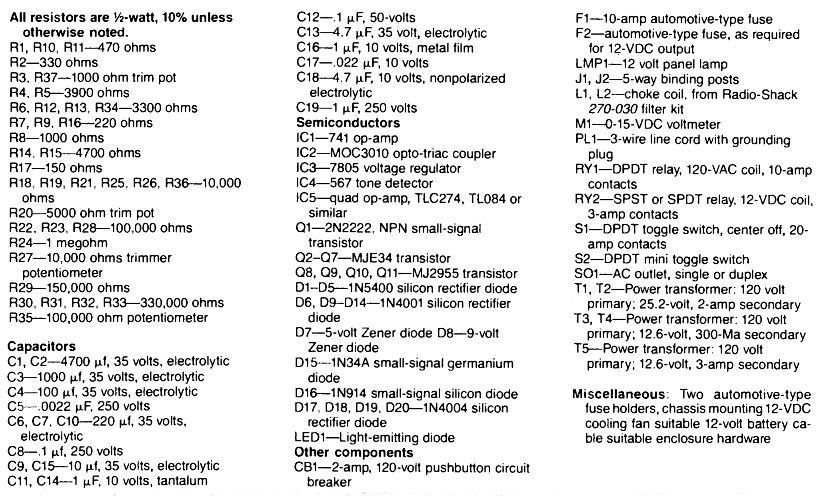
How to Construct the L1, L2 filter chokes
If you are unable to obtain the suggested L1, L2 chokes from your part dealer, you can construct the same using the following configuration
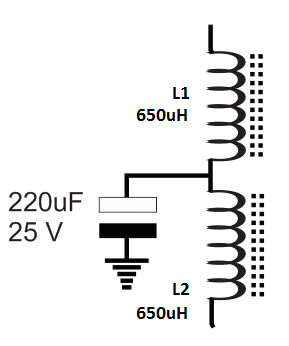
Use 1 mm super enameled wire for the coils
Dear Sir Is it Possible to convert my pc ups Sine wave ups??
Hello Jobayer,
yes it is possible if the complete schematic diagram of the UPS is available.
hello mr. swagatam, please why my inverter when i connect the transformer will not work, and the mosfets will began to take heat???
Hello Abdullahi, I will have to see the schematic of the inverter to understand the problem….
Yes, setting the frequency through Jimper, I have set it for 60 hz.
Pin 4 is connected to ground, according to the circuit diagram, but companies selling egs 002 in Vietnam write on the technical specifications of pin 4. Adjusting the frequency is absurd.
For a long time, I still don’t trust Vietnamese and Chinese websites, so I choose websites from advanced countries.
As far as I know, pin#4 is just a direct ground pin, and does not have any other function, so it cannot be used for setting up frequency.
Chào ngài, vì trang https://www.homemade-circuits.com/egs002-datasheet-circuit-diagram-explained/ của ngài tôi không tham gia thảo luận được nên tôi vào trang này để hỏi ngài.
Tôi thấy nhà sản suất Egs002 họ nói chân số 4 (pin 4) điều chỉnh được tần số sóng sin, tôi không hiểu điều chỉnh bằng cách nào.
Hello Thieu,
Pin#4 is ground, it cannot be used to set frequency.
You can set it through jumpers.
JP1 shorted sets AC output to 60Hz
Shorting JP5 sets the frequency to 50Hz
Still can’t post sir.
Could you please allow me to use another email?
As for Egs002, I guess the feedback voltage to pin15 is too large, so I increased the 200k resistor to 370k, so the output Ac power is 96v.
See if it’s possible.
Yes, that’s correct, you will have to adjust the resistive divider at pin15 of the EGS to optimize the output voltage level range…
Hello sir, I don’t understand why I can’t post my question on the page following your link.
Before, I was able to post it once, but later when I texted it, it didn’t work.
Hello Thieu, If you can post your comment on this page then you should be able to post under the EGS002 article also, please try again once.
…sorry for the inconvenience.
Cũng không dễ chút nào ngài ạ. Tôi sử dụng mosfet IRF 840 điện áp D-S: 500v, công suất 125W, Cầu nắn cho điện DC 134v đến 310v là biến áp cách ly có điều chỉnh điện áp ra công suất 450 W bằng 4 diot 4A/600v để cấp cho mosfét. Như thế là điện áp cao áp cấp vào đủ công suất rồi, thế. nhưng khi cấp điên 134v cho mosfet ( tất nhiên là phải điều chỉnh lại điện áp pin15 egs002 để cho nó hoạt động).
thì điện áp AC đầu ra chỉ được 51v, vi chỉnh R10k cũng chỉ lên được 51v. Tôi tăng điện áp đầu vào lên 250vDC nhưng nó vẫn trơ ra ở mức 51vAC ở đầu ra. Tôi đo tần số được 60 Hz song cũng không ổn định bằng đẻ mặc định 50 Hz.
Tôi chưa tìm ra được lỗi trên.
Thieu, please post this question under the following article, I will try to solve it.
https://www.homemade-circuits.com/egs002-datasheet-circuit-diagram-explained/
Hello sir, have a nice Sunday.
I installed the inverter from module EGS002, I assembled the circuit diagram correctly. I tried powering the mosfet -/+ 15v and the output voltage was 10.6v AC and the led flashed 4 times after 2 seconds the circuit worked and the cycle repeated. I measured the battery voltage of 15 egs002 and the voltage was low (below 2v). I tried adjusting R10k but it still didn’t work. I changed the 10k ground resistor to 20k so that the voltage of battery 15 was above +2v so the circuit would work normally.
I should replace R 10k with 20k so that the battery 15 > 4.3v > 2v is that ok?
Hello Thieu,
You can use 20k as the feedback preset if it is helping you to solve the issue. That’s fine.
If you have additional questions related to EGS002, you can comment under the following article:
https://www.homemade-circuits.com/egs002-datasheet-circuit-diagram-explained/
Hello sir, I see that we Vietnamese people use the EGS002 circuit to install a standard sine wave incerter. I would like to ask you, does that circuit properly create a standard sine wave?
If I use egs002 to install an H-bridge inverter, will it be adjusted to output a frequency of 60 Hz?
I. I suspect egs002 is a Chinese product, and I don’t use Chinese products.
Hello Thieu, yes it is a very efficient board for an H-bridge sine wave inverter, it can be be adjusted to output a frequency of 60 Hz…
Vâng, tôi lắp ráp mạch inverter như ngài đoán.
Tôi sẽ quấn biến áp 6-0-6 / 100v xem sao.
Xin chào ngài.
That’s great Thieu, let me know how it goes, and feel free to share the results.
If possible please share the results under the following post:
https://www.homemade-circuits.com/modified-sine-wave-inverter-circuit-2/
Hello sir, I am in Vietnam, the national power grid has a frequency of 50 hz. My goal is to convert the 50 to 60 hz power to run reel to reel 100v/ 60 hz (I don’t want to run 50 hz because the motor overheats).
I use old UPS transformers because the quality is better than new ones.
I’m not an electronic engineer so I don’t understand the magnetic saturation of fermalloy foils, but I think that if we supply the input coil with an AC voltage value, the output coil will have a voltage value. proportional to the number of turns/volt of the transformer.
I need 100 volts of electricity, so I supply +/- to the mosfet with an appropriate voltage value so that the output AC power is enough 100 volts, not necessarily +/- 12 or 24 volts with the battery.
In the 555 and 4017 ic circuits, I supply 12v power and the mosfet I supply +/- 15 to 17v to output 100v.
I have to create a 15v source from a low voltage transformer and adjust the diode bridge so that the current is large enough to be compatible with the battery. to avoid voltage drop under load.
(I used this type of power supply for a standard sine UPS to get clean, noise-free power for my Hi-end system).
I don’t understand much about Mosfet, so I’ll change to a new one and see if it works.
I have never successfully assembled a standard sine inverter, it is too difficult.
Hello Thieu, I guess you are referring to the following design:
" rel="ugc">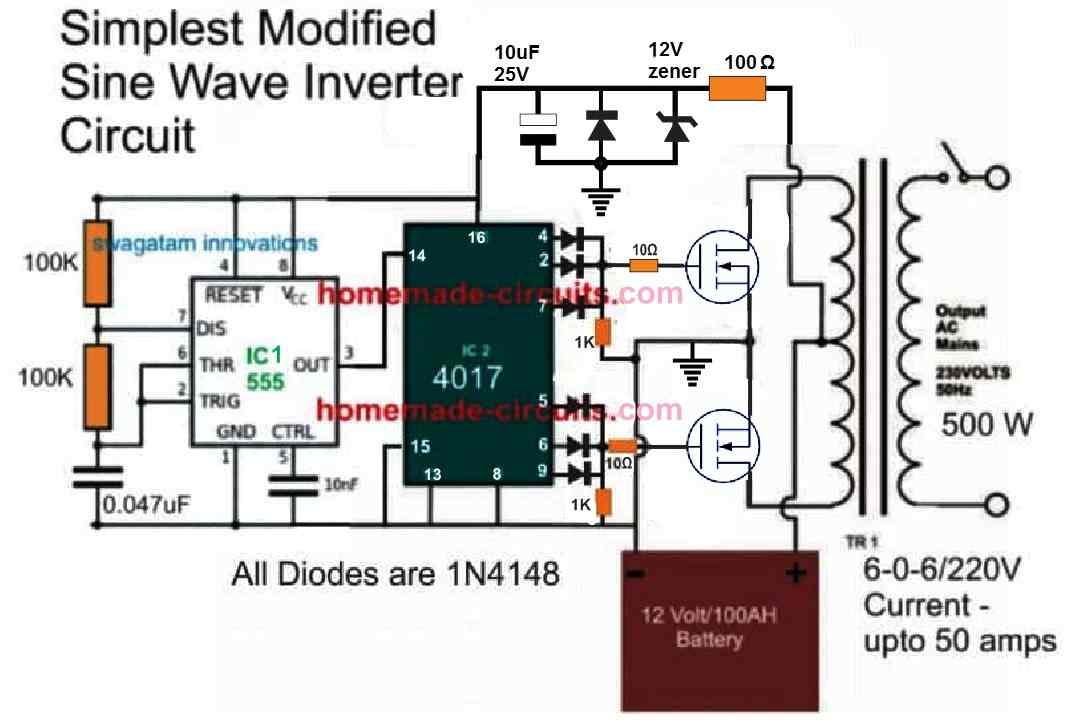
In this design if you want to operate a 100V 100 watt load,
You must use a 6-0-6V / 110V transformer
Battery should 12V and above 50 Ah.
If you do the above correctly, your output voltage will not drop.
Thank you, I have tested many standard sine wave ups, so I also have many types of transformers and mosfets. For now, I’m using a 3000 v/a iron transformer with an input ratio of 220v to 34v, mosfet F1433sg taken from an old 300v/a UPS board
Battery: 12v/ 30ah
Load capacity 100v/ 60 hz: 100 w.
I tried switching to another UPS’s iron transformer with a capacity of 300 W, but the output voltage still drops about 20 to 40v when there is a load and the frequency also decreases when there is a load.
I also took the entire circuit including the mosfet and the accompanying iron transformer of 1 1000w ups but there was also a voltage drop.
Please help me.
(the wires I used had enough current for the circuit)
Thank you for providing the details.
If your transformer output is 220V then the load voltage should be also 220V, it cannot be 100V.
Next, I would recommend using new appropriately rated MOSFETs, instead of the ones taken from the old UPS.
If the battery is a lead acid battery then a 30 Ah will be able to provide only 3 to 5 amps max, which might not be sufficient to operate a 100 watt load, make sure to have a 70 Ah battery.
Let me know if you have any further doubts or questions.
Kính chào ngài, xin ngài chỉ dẫn cách ổn định điện áp đẩu ra mạch inverter ic cd4017
Hello sir, I assembled a Simplest modified inverter circuit with a capacity of 300w using IC 555 and CD4017 to create a power source with a frequency of 60 hz. I intentionally created a 60 hz source because I used Reel to Reel Teac from Japan which has 3 100v/ 60 hz motors. This reel to reel was manufactured in 1957, it is the same age as me so I like it very much and I also DIY electric circuits using a Tube to listen to music.
I took advantage of old iron transformers from ubs to install it at 100v/60 hz.
I tested the inverter and saw the following problems:
Voltage drop under load, automatic frequency change under load, even though the transformer and Mosfet has a very large capacity of old ups from Integrap.
Please let me know if I should run Reel to Reel with a modified sine power source.
Hello Thieu,
Thank you for trying the 555/4017 based modified inverter circuit.
Please note that along with the transformer and the mosfets, your battery should be also rated appropriately as per the load specifications.
If your inverter voltage is dropping that simply means that either your transformer, or mosfet or the battery is not able to supply the required current to the load.
If you tell me the wattage or AMPERE specifications of your transformer, MOSFETs, battery and load, I will try to figure out the problem for you.
Hello sir, I have a Santak 300 V/A Ups using Ic 3525 for square wave output according to the manufacturer. I can modify pin 6 of ic 3525 to increase the output frequency to 60 hz and then add an oscillator Ic 555 and BJTs (according to your circuit diagram designed for ic 3525…) to create waveforms. Can Sin output correctly? Looking forward to your advice.
Thank you.
Hello Thieu,
Yes you can go ahead with the mentioned modifications.
Thank you, because 20 years ago (2004) I adjusted 1 Ups and gave it a frequency of 60 hz. Now I can’t find the adjustment button on the new Ups. My UPS is specialized for computer room servers.
I understand, however without seeing the circuit diagram or the layout diagram it can be impossible to know which preset needs to adjusted for the frequency.
Hello, I need the 60 hz out frequency of the ups with the manufacturer’s standard sine wave. Can you help me modifi?
Thank you
Hello, modification of an existing UPS can be difficult, unless the full schematic with description is available.
Gracias por tus publicaciones exelentes,aquí en Argentina nos son de mucha utilidad,nos estamos preparando para las próximas contingencias negativas que se avecinan,locales y a nivel mundial,(observar mapa scalion),mis mas Cinceros saludos
Miguel Angel Bustos,LU5HVI.
Thank you for your kind feedback, I appreciate it very much.
Hi Swagatam,
I need one inverter circuit, input to the inverter is 12V DC and desired output 50V AC @ 500mAmp output current. output frequency is about 50 to 60Hz.
Could you please help on this?
-Sateesh.
Hi Sateesh, to get 50 V AC output, you will need a 12V to 50 V transformer which is difficult to find in the market.
Hello Swagatham, I think, there is a typo: “The essential voltage step-up is implemented by the transformers T3 and T4, which are also typical power transformers configured in the reverse order.” should refer to T5 and T6 instead.
Also, I think T3 and T4 should have a 1:1 winding instead of 12.6V to 120V.
Am I wrong?
BR Phu
Thank you, Phu, for notifying about the mistake. I will correct it soon.
..yes the transformer must be 1:1, with a voltage rating of 12V….the diagram was probably taken from some book, and this was contributed by an external author.
Dear Sir,
Please help me 5 kw transformer less online inverter/ups circuit.48/96 volt.